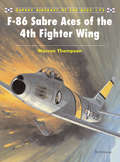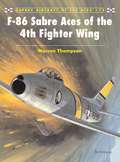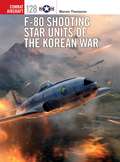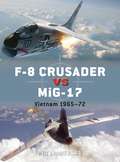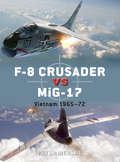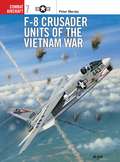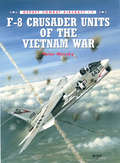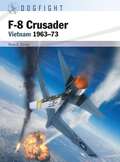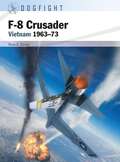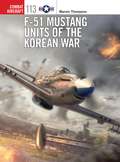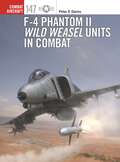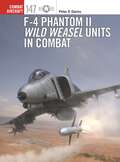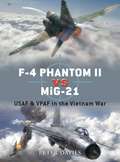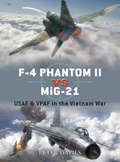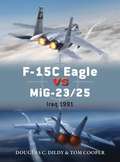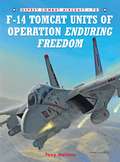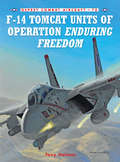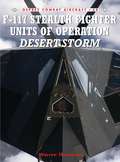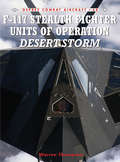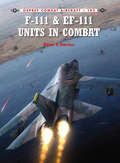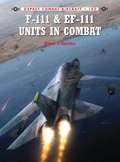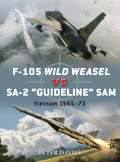- Table View
- List View
F-86 Sabre Aces of the 4th Fighter Wing (Aircraft of the Aces #72)
by Mark Styling Mr Warren ThompsonThe entry of the United State's premier jet interceptor into the Korean War was triggered by the ever-increasing presence of the Soviet-built MiG-15 south of the Yalu River. The possibility of the USAF losing air supremacy over the Korean Peninsula was unacceptable. The 4th Fighter Wing got the call for combat in Korea. They were made up of a combination of new pilots right out of jet training and the older combat veterans of World War II vintage. This combination of pilot types wrote and re-wrote the text books on jet warfare. Of the 40 jet aces that the war produced, the 4th Wing boasted 24 of them. This book details these incredible pilots and the planes they flew.
F-86 Sabre Aces of the 4th Fighter Wing (Aircraft of the Aces #72)
by Mark Styling Warren ThompsonThe entry of the United State's premier jet interceptor into the Korean War was triggered by the ever-increasing presence of the Soviet-built MiG-15 south of the Yalu River. The possibility of the USAF losing air supremacy over the Korean Peninsula was unacceptable. The 4th Fighter Wing got the call for combat in Korea. They were made up of a combination of new pilots right out of jet training and the older combat veterans of World War II vintage. This combination of pilot types wrote and re-wrote the text books on jet warfare. Of the 40 jet aces that the war produced, the 4th Wing boasted 24 of them. This book details these incredible pilots and the planes they flew.
F-80 Shooting Star Units of the Korean War (Combat Aircraft)
by Warren ThompsonBuilt within a 180-day time limit in 1943, the F-80 Shooting Star first saw service in Italy in the final year of World War 2, and consequently was sent to bases in the US, Europe and the Far East after VJ Day. It was the latter groups based in Japan that initially bore the brunt of the early fighting in Korea, engaging MiG-15s in the world's first jet-versus-jet combat. Flown principally by the 8th and 49th Fighter Bomber Wings, the F-80 served until the end of the war, completing an astonishing 98,515 combat sorties, shooting down 17 aircraft (including three of the vastly superior MiG-15s), dropping over 33,000 tons of bombs, and firing over 80,000 air-to-ground rockets. Aside from the fighter-bomber Shooting Stars, the ultra-rare, but heavily used, photo-reconnaissance RF-80A saw extensive use in the frontline in Korea as a replacement for the vulnerable RF-51D. Filled with first-hand accounts and rare colour photographs taken by the veterans themselves, this is the engrossing story of the pioneering F-80 Shooting Star.
F-80 Shooting Star Units of the Korean War (Combat Aircraft #128)
by Warren ThompsonBuilt within a 180-day time limit in 1943, the F-80 Shooting Star first saw service in Italy in the final year of World War 2, and consequently was sent to bases in the US, Europe and the Far East after VJ Day. It was the latter groups based in Japan that initially bore the brunt of the early fighting in Korea, engaging MiG-15s in the world's first jet-versus-jet combat. Flown principally by the 8th and 49th Fighter Bomber Wings, the F-80 served until the end of the war, completing an astonishing 98,515 combat sorties, shooting down 17 aircraft (including three of the vastly superior MiG-15s), dropping over 33,000 tons of bombs, and firing over 80,000 air-to-ground rockets. Aside from the fighter-bomber Shooting Stars, the ultra-rare, but heavily used, photo-reconnaissance RF-80A saw extensive use in the frontline in Korea as a replacement for the vulnerable RF-51D. Filled with first-hand accounts and rare colour photographs taken by the veterans themselves, this is the engrossing story of the pioneering F-80 Shooting Star.
F-8 Crusader vs MiG-17: Vietnam 1965-72 (Duel)
by Jim Laurier Peter Mersky Gareth HectorRevered by Naval Aviators as the 'last of the gunfighters' due to its quartet of Colt-Browning Mk 12 20 mm cannon, the F-8 Crusader enjoyed great success against VPAF MiG-17s during the Rolling Thunder campaign of 1966–68. But, the MiG-17's unequalled low-speed manoeuvrability, small size and powerful cannon armament meant that the American forces didn't have it all their own way. This fully illustrated book, featuring photographs, maps and battlescene artwork, reveals the tactics that were developed by pilots on both sides to give themselves the edge in air-to-air dogfights, allowing the reader to understand how the differing design and development doctrines played a part in combat.
F-8 Crusader vs MiG-17: Vietnam 1965-72 (Duel #61)
by Jim Laurier Peter Mersky Gareth HectorRevered by Naval Aviators as the 'last of the gunfighters' due to its quartet of Colt-Browning Mk 12 20 mm cannon, the F-8 Crusader enjoyed great success against VPAF MiG-17s during the Rolling Thunder campaign of 1966–68. But, the MiG-17's unequalled low-speed manoeuvrability, small size and powerful cannon armament meant that the American forces didn't have it all their own way. This fully illustrated book, featuring photographs, maps and battlescene artwork, reveals the tactics that were developed by pilots on both sides to give themselves the edge in air-to-air dogfights, allowing the reader to understand how the differing design and development doctrines played a part in combat.
F-8 Crusader Units of the Vietnam War (Combat Aircraft)
by Tom Tullis Peter MerskyKnown to its pilots as the 'last of the gunfighters' due to its quartet of Colt-Browning Mk 12 20 mm cannon, the F-8 Crusader was numerically the most populous fighter in the US Navy at the start of America's involvement in the Vietnam conflict in 1964 – some 482 F-8C/D/Es equipped 17 frontline units. It enjoyed great success against North Vietnamese Mig-17s and Mig-21s during the Rolling Thunder campaign of 1965-68, officially downing 18 jets, which represented 53 per cent of all Mig claims lodged by Navy squadrons during this period.
F-8 Crusader Units of the Vietnam War (Combat Aircraft)
by Tom Tullis Peter MerskyKnown to its pilots as the 'last of the gunfighters' due to its quartet of Colt-Browning Mk 12 20 mm cannon, the F-8 Crusader was numerically the most populous fighter in the US Navy at the start of America's involvement in the Vietnam conflict in 1964 – some 482 F-8C/D/Es equipped 17 frontline units. It enjoyed great success against North Vietnamese Mig-17s and Mig-21s during the Rolling Thunder campaign of 1965-68, officially downing 18 jets, which represented 53 per cent of all Mig claims lodged by Navy squadrons during this period.
F-8 Crusader: Vietnam 1963–73 (Dogfight #7)
by Peter E. DaviesWith specially commissioned artworks and dynamic combat ribbon diagrams, this volume reveals how the 'last of the gunfighters', as the F-8 was dubbed by its pilots, prevailed against the growing MiG threat of the Vietnamese People's Air Force. When the Vietnam War began, the F-8 was already firmly established as a fighter and reconnaissance aircraft. It entered combat as an escort for Alpha strike packages, braving the anti-aircraft artillery and surface-to-air missiles alongside the A-4 Skyhawk bombers and meeting MiGs for the first time on 3 April 1965. Although the Crusader was nicknamed 'last of the gunfighters', its pilots employed 'secondary' AIM-9D Sidewinder missiles in all but one of their MiG kills, with guns also used as back-up in three. Its 20 mm guns were unreliable as they often jammed during strenuous manoeuvres, although they were responsible for damaging a number of MiGs. However, in combat the F-8 had the highest 'exchange ratio' (kills divided by losses) at six-to-one of any US combat aircraft involved in the Vietnam War. Through the copious use of first-hand accounts, highly detailed battlescene artwork, combat ribbon diagrams and armament views, Osprey's Vietnam air war specialist Peter E. Davies charts the successful career of the F-8 Crusader over Vietnam.
F-8 Crusader: Vietnam 1963–73 (Dogfight #7)
by Peter E. DaviesWith specially commissioned artworks and dynamic combat ribbon diagrams, this volume reveals how the 'last of the gunfighters', as the F-8 was dubbed by its pilots, prevailed against the growing MiG threat of the Vietnamese People's Air Force. When the Vietnam War began, the F-8 was already firmly established as a fighter and reconnaissance aircraft. It entered combat as an escort for Alpha strike packages, braving the anti-aircraft artillery and surface-to-air missiles alongside the A-4 Skyhawk bombers and meeting MiGs for the first time on 3 April 1965. Although the Crusader was nicknamed 'last of the gunfighters', its pilots employed 'secondary' AIM-9D Sidewinder missiles in all but one of their MiG kills, with guns also used as back-up in three. Its 20 mm guns were unreliable as they often jammed during strenuous manoeuvres, although they were responsible for damaging a number of MiGs. However, in combat the F-8 had the highest 'exchange ratio' (kills divided by losses) at six-to-one of any US combat aircraft involved in the Vietnam War. Through the copious use of first-hand accounts, highly detailed battlescene artwork, combat ribbon diagrams and armament views, Osprey's Vietnam air war specialist Peter E. Davies charts the successful career of the F-8 Crusader over Vietnam.
F-51 Mustang Units of the Korean War (Combat Aircraft)
by Chris Davey Warren Thompson Gareth HectorBy the time the Korean War erupted, the F-51 Mustang was seen as obsolete, but that view quickly changed when the USAF rushed 145 of them to the theatre in late 1950. They had the endurance to attack targets in Korea from bases in Japan, where the modern F-86 fighters and other jets did not. Rather than the interceptor and escort fighter roles the Mustang had performed during World War 2, in the Korean War they were assigned to ground attack missions – striking at communist troop columns advancing south. This is the chronicle of the Mustang units that fought in the Korean War, detailing the type's involvement in a series of intense actions, its successes and its considerable losses. Drawing on meticulous research and gripping first-hand accounts from aircrew, this book explains how the faithful Mustang was able to roll back the years, fight, and prove itself in a new era of aerial warfare.
F-51 Mustang Units of the Korean War (Combat Aircraft #113)
by Gareth Hector Mr Chris Davey Mr Warren ThompsonBy the time the Korean War erupted, the F-51 Mustang was seen as obsolete, but that view quickly changed when the USAF rushed 145 of them to the theatre in late 1950. They had the endurance to attack targets in Korea from bases in Japan, where the modern F-86 fighters and other jets did not. Rather than the interceptor and escort fighter roles the Mustang had performed during World War 2, in the Korean War they were assigned to ground attack missions – striking at communist troop columns advancing south. This is the chronicle of the Mustang units that fought in the Korean War, detailing the type's involvement in a series of intense actions, its successes and its considerable losses. Drawing on meticulous research and gripping first-hand accounts from aircrew, this book explains how the faithful Mustang was able to roll back the years, fight, and prove itself in a new era of aerial warfare.
F-4 Phantom II Wild Weasel Units in Combat (Combat Aircraft)
by Peter E. DaviesWith first-hand insight into the into the key role of the US Air Force's fighter-bomber from the Vietnam War through to Operation Desert Storm during the First Gulf War, this book is an unmissable account of some of the most dangerous and demanding missions in the two wars.The advent of the surface-to-air missile (SAM) in the early 1950s threatened the whole concept of aerial bombing from medium and high altitude. Countermeasures were developed during the Korean War, but with little initial success. It was only in the closing stages of the Vietnam War, with the F-4Cww Phantom II (Wild Weasel 4), that this equipment started to become successful enough to allow a substantial investment in converting 116 F-4E Phantom IIs into dedicated SEAD aircraft. This move introduced a new generation of anti-radar missiles which became invaluable in later operations including operations Desert Shield, Desert Storm and Northern Watch over Iraq. This volume features dynamic archival photography from crews who flew the jet, alongside mission accounts and technical details of the development and fielding of the F-4 Wild Weasel in its various iterations. Including specially commissioned artwork of 'sharkmouthed' Phantom IIs in Vietnam jungle camouflage and more modern USAF 'Ghost Gray', this book is the ultimate visual and technical guide to the F-4 Phantom II Wild Weasel Units in combat.
F-4 Phantom II Wild Weasel Units in Combat (Combat Aircraft)
by Peter E. DaviesWith first-hand insight into the into the key role of the US Air Force's fighter-bomber from the Vietnam War through to Operation Desert Storm during the First Gulf War, this book is an unmissable account of some of the most dangerous and demanding missions in the two wars.The advent of the surface-to-air missile (SAM) in the early 1950s threatened the whole concept of aerial bombing from medium and high altitude. Countermeasures were developed during the Korean War, but with little initial success. It was only in the closing stages of the Vietnam War, with the F-4Cww Phantom II (Wild Weasel 4), that this equipment started to become successful enough to allow a substantial investment in converting 116 F-4E Phantom IIs into dedicated SEAD aircraft. This move introduced a new generation of anti-radar missiles which became invaluable in later operations including operations Desert Shield, Desert Storm and Northern Watch over Iraq. This volume features dynamic archival photography from crews who flew the jet, alongside mission accounts and technical details of the development and fielding of the F-4 Wild Weasel in its various iterations. Including specially commissioned artwork of 'sharkmouthed' Phantom IIs in Vietnam jungle camouflage and more modern USAF 'Ghost Gray', this book is the ultimate visual and technical guide to the F-4 Phantom II Wild Weasel Units in combat.
F-4 Phantom II vs MiG-21: USAF & VPAF in the Vietnam War (Duel #12)
by Jim Laurier Tom Tullis Gareth Hector Peter E. DaviesThis book draws us into the dangerous world braved by American and North Vietnamese airmen in the skies over Vietnam. Influential leaders and tacticians are profiled to provide a comparative evaluation of their contrasting skills. This book also reveals the technical specifications of each jet with an analysis of the weaponry, avionics and survival devices of the F-4 Phantom II as flown by the USAF and the MiG-21. The fighters' strengths and weaknesses are also compared, including turn radius, performance at altitude, range and structural integrity. First-person extracts reflect on the dangers of these aerial duels, as USAF pilots and their counterparts struggled to overcome each plane's shortcomings.
F-4 Phantom II vs MiG-21: USAF & VPAF in the Vietnam War (Duel #12)
by Jim Laurier Tom Tullis Gareth Hector Peter E. DaviesThis book draws us into the dangerous world braved by American and North Vietnamese airmen in the skies over Vietnam. Influential leaders and tacticians are profiled to provide a comparative evaluation of their contrasting skills. This book also reveals the technical specifications of each jet with an analysis of the weaponry, avionics and survival devices of the F-4 Phantom II as flown by the USAF and the MiG-21. The fighters' strengths and weaknesses are also compared, including turn radius, performance at altitude, range and structural integrity. First-person extracts reflect on the dangers of these aerial duels, as USAF pilots and their counterparts struggled to overcome each plane's shortcomings.
F-15C Eagle vs MiG-23/25: Iraq 1991 (Duel)
by Jim Laurier Doug Dildy Tom CooperDesigned following the relatively poor performance of America's multi-role fighters during the Vietnam War, the F-15 Eagle was conceived as a dedicated air superiority fighter. But, having trained for 15 years in the Eagle it wasn't Eastern Bloc operated MiGs that the F-15 eventually came up against, but pilots of Saddam Hussein's Iraqi airforce.This book analyses the combat between the American and Soviet 'Cold War fighters' in a balanced manner, examining how the technical abilities of the aircraft combined with the different levels of training available to opposing pilots and groundcrews allowed the F-15s to destroy the Iraqi offensive abilities within weeks of the First Gulf War starting. Packed with artwork, illustrations and photographs, this book places the reader in the cockpit during one of the last major dogfighting air wars in modern history.
F-15C Eagle vs MiG-23/25: Iraq 1991 (Duel)
by Jim Laurier Doug Dildy Tom CooperDesigned following the relatively poor performance of America's multi-role fighters during the Vietnam War, the F-15 Eagle was conceived as a dedicated air superiority fighter. But, having trained for 15 years in the Eagle it wasn't Eastern Bloc operated MiGs that the F-15 eventually came up against, but pilots of Saddam Hussein's Iraqi airforce.This book analyses the combat between the American and Soviet 'Cold War fighters' in a balanced manner, examining how the technical abilities of the aircraft combined with the different levels of training available to opposing pilots and groundcrews allowed the F-15s to destroy the Iraqi offensive abilities within weeks of the First Gulf War starting. Packed with artwork, illustrations and photographs, this book places the reader in the cockpit during one of the last major dogfighting air wars in modern history.
F-14 Tomcat Units of Operation Enduring Freedom (Combat Aircraft)
by Jim Laurier Tony HolmesThe legendary F-14 Tomcat was the weapon of choice to strike against the enemies of the United States in the wake of the September 11 attacks, with F-14s flying thousands of bombing missions on al-Qaeda and Taliban positions. Written by aviation expert Tony Holmes, this book explores the F-14 pilots and aircraft involved in Operation Enduring Freedom, with insights into the tactical approach and strategic aims provided by officers. Exclusive access to mission reports, combat diaries, fullcolour artwork and photographs from the author's collection reveal the battle experiences of the most famous modern fast jet.
F-14 Tomcat Units of Operation Enduring Freedom (Combat Aircraft #70)
by Jim Laurier Tony HolmesThe legendary F-14 Tomcat was the weapon of choice to strike against the enemies of the United States in the wake of the September 11 attacks, with F-14s flying thousands of bombing missions on al-Qaeda and Taliban positions. Written by aviation expert Tony Holmes, this book explores the F-14 pilots and aircraft involved in Operation Enduring Freedom, with insights into the tactical approach and strategic aims provided by officers. Exclusive access to mission reports, combat diaries, fullcolour artwork and photographs from the author's collection reveal the battle experiences of the most famous modern fast jet.
F-117 Stealth Fighter Units of Operation Desert Storm (Combat Aircraft)
by Mark Styling Warren ThompsonDuring the final years of the 20th century, the most significant break-through in military weaponry was the concept of Stealth technology, and the first mass-produced weapon to utilize this to perfection was the F-117 Nighthawk. Originally delivered in 1982, its existence was officially denied until the Iraqi invasion of Kuwait, when it entered the public spotlight over the skies of Baghdad. Illustrated with stunning color photographs of the F-117 above Iraq, and complemented by numerous personal accounts from the pilots themselves, this book explores the history and combat experience of one of the most secretive planes ever built.
F-117 Stealth Fighter Units of Operation Desert Storm (Combat Aircraft)
by Mark Styling Warren ThompsonDuring the final years of the 20th century, the most significant break-through in military weaponry was the concept of Stealth technology, and the first mass-produced weapon to utilize this to perfection was the F-117 Nighthawk. Originally delivered in 1982, its existence was officially denied until the Iraqi invasion of Kuwait, when it entered the public spotlight over the skies of Baghdad. Illustrated with stunning color photographs of the F-117 above Iraq, and complemented by numerous personal accounts from the pilots themselves, this book explores the history and combat experience of one of the most secretive planes ever built.
F-111 & EF-111 Units in Combat (Combat Aircraft #102)
by Peter E. DaviesThe General Dynamics F-111 was one of the most technically innovative designs among military aircraft, introducing the variable-sweep wing, terrain-following radar, military-rated afterburning turbofan engines and a self-contained escape module among other features. Designed as a cost-saving, multi-role interceptor, naval fighter and strike bomber, its evolution prioritised the latter role and it became the USAF's most effective long-range strike aircraft during three decades of service. Rushed into combat in Vietnam before some of its structural issues were fully understood, the type suffered several early losses and gained an unfairly negative reputation that dogged it for the rest of its career, and restricted funding for more advanced versions of the design. However, in Operation Linebacker in 1972 the F-111 flew 4000 nocturnal under-the-radar missions, delivering, with unprecedented accuracy, many decisive blows that would have resulted in heavy losses for any other attack aircraft.
F-111 & EF-111 Units in Combat (Combat Aircraft #102)
by Rolando Ugolini Peter E. DaviesThe General Dynamics F-111 was one of the most technically innovative designs among military aircraft, introducing the variable-sweep wing, terrain-following radar, military-rated afterburning turbofan engines and a self-contained escape module among other features. Designed as a cost-saving, multi-role interceptor, naval fighter and strike bomber, its evolution prioritised the latter role and it became the USAF's most effective long-range strike aircraft during three decades of service. Rushed into combat in Vietnam before some of its structural issues were fully understood, the type suffered several early losses and gained an unfairly negative reputation that dogged it for the rest of its career, and restricted funding for more advanced versions of the design. However, in Operation Linebacker in 1972 the F-111 flew 4000 nocturnal under-the-radar missions, delivering, with unprecedented accuracy, many decisive blows that would have resulted in heavy losses for any other attack aircraft.
F-105 Wild Weasel vs SA-2 ‘Guideline’ SAM: Vietnam 1965–73 (Duel)
by Jim Laurier Gareth Hector Peter E. DaviesThe Vietnam war was the first conflict that saw extensive use of surface-to-air anti-aircraft missiles, and thus became a training ground for the tactics of this new type of battle. This Duel presents this story in the context of two of the main opponents: America's top fighter-bomber and the NVA's best anti-aircraft missile.
